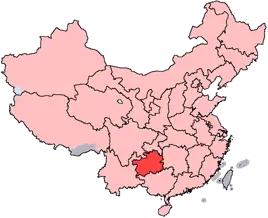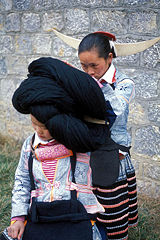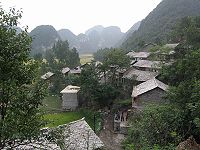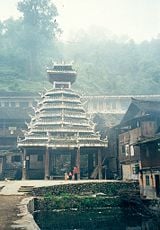Difference between revisions of "Guizhou" - New World Encyclopedia
Nim Ruparel (talk | contribs) |
Nim Ruparel (talk | contribs) |
||
| Line 36: | Line 36: | ||
| Website = http://www.gzgov.gov.cn<br/>([[Simplified Chinese]]) | | Website = http://www.gzgov.gov.cn<br/>([[Simplified Chinese]]) | ||
}} | }} | ||
| − | '''{{Audio|zh-Guizhou.ogg|Guizhou}}''' ({{zh-stpw |s=贵州 |t=貴州 |p=Gùizhōu |w=Kuei-chou}}; also spelled ''Kweichow'') is a [[political divisions of China|province]] of the [[People's Republic of China]] located in the southwestern part of the country. Its provincial capital city is [[Guiyang]]. | + | '''{{Audio|zh-Guizhou.ogg|Guizhou}}''' ({{zh-stpw |s=贵州 |t=貴州 |p=Gùizhōu |w=Kuei-chou}}; also spelled ''Kweichow'') is a [[political divisions of China|province]] of the [[People's Republic of China]] located in the southwestern part of the country. Guizhou borders [[Sichuan]] province and [[Chongqing Municipality]] to the north, [[Yunnan]] province to the west, [[Guangxi]] province to the south and [[Hunan]] province to the east. Its provincial capital city is [[Guiyang]]. |
== History == | == History == | ||
| − | Guizhou was well known by the Chinese for thousands of years but it was not until the [[Ming dynasty]] that it came under Chinese domination during which it was made a province. This prompted mass migration from [[Sichuan]], [[Hunan]] and | + | Guizhou was well known by the Chinese for thousands of years but it was not until the [[Ming dynasty]] that it came under Chinese domination, during which it was made into a province. This prompted mass migration from the neighboring provinces of [[Sichuan]], [[Hunan]] and other provinces into Guizhou. |
| − | Countless rebellions by its native [[Hmong people|Miao]] people occurred throughout the [[Qing dynasty]]. It was said | + | Countless rebellions by its native [[Hmong people|Miao]] people occurred throughout the [[Qing dynasty]]. It was said that under the [[Qing dynasty]] every thirty years there would be minor revolts, while every sixty years there would be major rebellions. All the revolts would be violently suppressed by the government. |
== Geography == | == Geography == | ||
[[Image:Shitoucun,Longtanzhen,Guizhou,China.jpg|thumb|200px|Bouyei minority Shitou village, west Guizhou (near Longgong caves), China.]] | [[Image:Shitoucun,Longtanzhen,Guizhou,China.jpg|thumb|200px|Bouyei minority Shitou village, west Guizhou (near Longgong caves), China.]] | ||
| − | + | Guizhou is a mountainous province, however most of the hilly areas are concentrated in the west, while the eastern and southern portions are relatively flat. The western part of the province forms part of the [[Yunnan-Guizhou Plateau]]. | |
| − | |||
| − | |||
Guizhou has a subtropical humid climate. There are few seasonal changes. Its annual average temperature is roughly 10 to 20[[Celsius|°C]], with January temperatures ranging from 1 to 10°C and July temperatures ranging from 17 to 28°C. | Guizhou has a subtropical humid climate. There are few seasonal changes. Its annual average temperature is roughly 10 to 20[[Celsius|°C]], with January temperatures ranging from 1 to 10°C and July temperatures ranging from 17 to 28°C. | ||
| − | Major Cities: | + | Major Cities: |
| − | *[[Anshun]] | + | *[[Guiyang]] |
| − | *[[Zunyi]] | + | *[[Anshun]] |
| + | *[[Kaili]] | ||
| + | *[[Zunyi]] | ||
| + | *[[Duyun]] | ||
| + | *[[Liupanshui]] | ||
| + | *[[Qingzhen]] | ||
== Administrative divisions == | == Administrative divisions == | ||
| Line 59: | Line 62: | ||
== Economy == | == Economy == | ||
| − | Guizhou is a relatively poor and undeveloped province. It also has a small economy compared to the coastal provinces. Its nominal [[GDP]] for [[2004]] was 159.2 billion yuan (19.75 billion USD). Its per capita GDP of 3568 RMB (470 USD) ranks last in all of the PRC | + | Guizhou is a relatively poor and undeveloped province. It also has a small economy compared to the other coastal provinces, which are much more affluent. Its nominal [[GDP]] for [[2004]] was 159.2 billion yuan (19.75 billion USD). Its per capita GDP of 3568 RMB (470 USD) ranks last in all of the [[People's Republic of China|PRC]] |
| − | Its natural industry includes timber and forestry. Other important industries in the province include energy ([[electricity generation]]) and mining, especially in [[coal]], [[limestone]], [[arsenic]], [[gypsum]], and [[oil shale]]. Guizhou's total output of coal was 110 million tons in 2005, a 12% growth from the previous year. [http://english.people.com.cn/200512/24/eng20051224_230502.html] | + | Its natural industry includes [[timber]] and forestry. Other important industries in the province include energy ([[electricity generation]]) and mining, especially in [[coal]], [[limestone]], [[arsenic]], [[gypsum]], and [[oil shale]]. Guizhou's total output of coal was 110 million tons in 2005, a 12% growth from the previous year. [http://english.people.com.cn/200512/24/eng20051224_230502.html] |
== Demographics == | == Demographics == | ||
[[Image:Longhorn_Miao_China.jpg|thumb|160px|left|The long-horn tribe, one of the small branches of [[Miao people|Miao]] living in the twelve villages near Zhijing (织金) County, Guizhou Province. The wooden horns remain daily attire for most women.]] | [[Image:Longhorn_Miao_China.jpg|thumb|160px|left|The long-horn tribe, one of the small branches of [[Miao people|Miao]] living in the twelve villages near Zhijing (织金) County, Guizhou Province. The wooden horns remain daily attire for most women.]] | ||
| − | Guizhou is | + | Guizhou is a province that contains a variety of different [[List of Chinese ethnic groups|minority groups]]. These minority groups account for more than 37% of the total population and they include the [[Yao people|Yao]], [[Miao people|Miao]], [[Yi people|Yi]], [[Qiang]], [[Dong people|Dong]], [[Zhuang]], [[Buyi]], [[Bai]], [[Tujia]], [[Gelao]] and [[Shui]] people. The population concentration of these minority groups is so high that 55.5% of the province area is designated as an autonomous region for them. Guizhou is the province with highest TFR in China with 2.19. (Urban-1.31, Rural-2.42) [http://txspace.tamu.edu/bitstream/1969.1/3892/1/etd-tamu-2005A-SOCI-Terrell.pdf] |
== Culture == | == Culture == | ||
| Line 75: | Line 78: | ||
The province has many [[covered bridge]]s, called ''Wind and Rain Bridges''. These were built by the [[Dong people|Dong minority people]]. | The province has many [[covered bridge]]s, called ''Wind and Rain Bridges''. These were built by the [[Dong people|Dong minority people]]. | ||
| − | The southeastern corner of the province is known for its unique Dong minority culture. Towns such as Rongjiang, Liping, Diping and Zhaoxing are scattered amongst the hills along the border with Guangxi. | + | The southeastern corner of the province is known for its unique Dong minority culture. Towns such as Rongjiang, Liping, Diping and Zhaoxing are scattered amongst the hills along the border with [[Guangxi]]. |
The rich population of minorities in Guizhou allow for a great many ethnic festivals throughout the lunar calendar. During the first lunar month (usually February), the early festival in Kaili (east of Guiyang) celebrates local culture with acts of bullfighting, horse racing, pipe playing, and comedy works. | The rich population of minorities in Guizhou allow for a great many ethnic festivals throughout the lunar calendar. During the first lunar month (usually February), the early festival in Kaili (east of Guiyang) celebrates local culture with acts of bullfighting, horse racing, pipe playing, and comedy works. | ||
| Line 95: | Line 98: | ||
==External links== | ==External links== | ||
{{commons|Guizhou}} | {{commons|Guizhou}} | ||
| − | *[http://www.gzgov.gov.cn Guizhou's Provincial Government (Chinese)] | + | *[http://www.gzgov.gov.cn Guizhou's Provincial Government (Chinese)] Retrieved September 20, 2007. |
| − | *[http://www.muztagh.com/images/map/map-of-guizhou-large.jpg Large map of Guizhou] | + | *[http://www.muztagh.com/images/map/map-of-guizhou-large.jpg Large map of Guizhou] Retrieved September 20, 2007. |
| − | *[http://www. | + | *[http://www.travelchinaguide.com/cityguides/guizhou/ Guizhou Travel Guide] Retrieved September 20, 2007. |
| + | *[http://www.unescap.org/esid/psis/population/database/chinadata/guizhou.htm UNESCAP] Retrieved September 20, 2007. | ||
| + | *[http://english.peopledaily.com.cn/data/province/guizhou.html People's Daily] Retrieved September 20, 2007. | ||
| + | *[http://www.china.org.cn/e-xibu/2JI/3JI/guizhou/guizhou-ban.htm Overview of Guizhou] Retrieved September 20, 2007. | ||
| + | *[http://library.thinkquest.org/20443/guizhou.html Guizhou Culture] Retrieved September 20, 2007. | ||
Revision as of 05:13, 21 September 2007
| 贵州省 Guìzhōu Shěng | |
| Abbreviations: 黔 or 贵 (Pinyin: Qián or Guì) | |

| |
| Origin of name | 贵 guì - Gui Mountains 州 zhōu - zhou (prefecture) |
| Administration type | Province |
| Capital (and largest city) |
Guiyang |
| CPC Ctte Secretary | Shi Zongyuan |
| Governor | Lin Shusen (acting) |
| Area | 176,100 km² (16th) |
| Population (2004) - Density |
39,040,000 (15th) 222/km² (18th) |
| GDP (2004) - per capita |
CNY 159.2 billion (26th) CNY 4010 (31st) |
| HDI (2005) | 0.639 (medium) (30th) |
| Major nationalities | Han - 62% Miao - 12% Buyi - 8% Dong - 5% Tujia - 4% Yi - 2% Undistinguished - 2% Gelao - 2% Shui - 1% |
| Prefecture-level | 9 divisions |
| County-level | 88 divisions |
| Township-level† | 1539 divisions |
| ISO 3166-2 | CN-52 |
| Official website http://www.gzgov.gov.cn (Simplified Chinese) | |
| Source for population and GDP data: 《中国统计年鉴—2005》 China Statistical Yearbook 2005 Source for nationalities data:ISBN 7503747382 《2000年人口普查中国民族人口资料》 Tabulation on nationalities of 2000 population census of China † As at December 31, 2004
ISBN 7105054255 | |
Guizhou ▶ (Simplified Chinese: 贵州; Traditional Chinese: 貴州; pinyin: Gùizhōu; Wade-Giles: Kuei-chou; also spelled Kweichow) is a province of the People's Republic of China located in the southwestern part of the country. Guizhou borders Sichuan province and Chongqing Municipality to the north, Yunnan province to the west, Guangxi province to the south and Hunan province to the east. Its provincial capital city is Guiyang.
History
Guizhou was well known by the Chinese for thousands of years but it was not until the Ming dynasty that it came under Chinese domination, during which it was made into a province. This prompted mass migration from the neighboring provinces of Sichuan, Hunan and other provinces into Guizhou.
Countless rebellions by its native Miao people occurred throughout the Qing dynasty. It was said that under the Qing dynasty every thirty years there would be minor revolts, while every sixty years there would be major rebellions. All the revolts would be violently suppressed by the government.
Geography
Guizhou is a mountainous province, however most of the hilly areas are concentrated in the west, while the eastern and southern portions are relatively flat. The western part of the province forms part of the Yunnan-Guizhou Plateau.
Guizhou has a subtropical humid climate. There are few seasonal changes. Its annual average temperature is roughly 10 to 20°C, with January temperatures ranging from 1 to 10°C and July temperatures ranging from 17 to 28°C.
Major Cities:
- Guiyang
- Anshun
- Kaili
- Zunyi
- Duyun
- Liupanshui
- Qingzhen
Administrative divisions
Economy
Guizhou is a relatively poor and undeveloped province. It also has a small economy compared to the other coastal provinces, which are much more affluent. Its nominal GDP for 2004 was 159.2 billion yuan (19.75 billion USD). Its per capita GDP of 3568 RMB (470 USD) ranks last in all of the PRC
Its natural industry includes timber and forestry. Other important industries in the province include energy (electricity generation) and mining, especially in coal, limestone, arsenic, gypsum, and oil shale. Guizhou's total output of coal was 110 million tons in 2005, a 12% growth from the previous year. [1]
Demographics

Guizhou is a province that contains a variety of different minority groups. These minority groups account for more than 37% of the total population and they include the Yao, Miao, Yi, Qiang, Dong, Zhuang, Buyi, Bai, Tujia, Gelao and Shui people. The population concentration of these minority groups is so high that 55.5% of the province area is designated as an autonomous region for them. Guizhou is the province with highest TFR in China with 2.19. (Urban-1.31, Rural-2.42) [2]
Culture
Guizhou is the home of the Moutai Distillery, distillers of Maotai liquor, China's most famous alcoholic beverage. The Chinese name of the distillery is Zhongguo Guizhou Maotai Jiuchang.
Tourism
The province has many covered bridges, called Wind and Rain Bridges. These were built by the Dong minority people.
The southeastern corner of the province is known for its unique Dong minority culture. Towns such as Rongjiang, Liping, Diping and Zhaoxing are scattered amongst the hills along the border with Guangxi.
The rich population of minorities in Guizhou allow for a great many ethnic festivals throughout the lunar calendar. During the first lunar month (usually February), the early festival in Kaili (east of Guiyang) celebrates local culture with acts of bullfighting, horse racing, pipe playing, and comedy works.
Miscellaneous topics
Colleges and universities
- Guizhou University (Guiyang)
Guizhou Normal University (Guiyang); Zunyi Medical College (Zunyi); Guiyang Medical University (Guiyang); Guizhou University for Nationalities (Guiyang); Guizhou College of Finace and Economics (Guiyang); Commercial College of Guizhou (Guiyang); Bijie University; Anshun Vocational and Technology College (Anshun)
Communications
Guizhou Daily
External links
- Guizhou's Provincial Government (Chinese) Retrieved September 20, 2007.
- Large map of Guizhou Retrieved September 20, 2007.
- Guizhou Travel Guide Retrieved September 20, 2007.
- UNESCAP Retrieved September 20, 2007.
- People's Daily Retrieved September 20, 2007.
- Overview of Guizhou Retrieved September 20, 2007.
- Guizhou Culture Retrieved September 20, 2007.
| Province-level divisions administered by the People's Republic of China (PRC) | |
|---|---|
| Provinces | Anhui · Fujian · Gansu · Guangdong · Guizhou · Hainan · Hebei · Heilongjiang · Henan · Hubei · Hunan · Jiangsu · Jiangxi · Jilin · Liaoning · Qinghai · Shaanxi · Shandong · Shanxi · Sichuan · Taiwan · Yunnan · Zhejiang |
| Autonomous regions | Guangxi · Inner Mongolia · Ningxia · Tibet (Xizang) · Xinjiang |
| Municipalities | Beijing · Chongqing · Shanghai · Tianjin |
| Special administrative regions | Hong Kong · Macau |
Template:Guizhou
Credits
New World Encyclopedia writers and editors rewrote and completed the Wikipedia article in accordance with New World Encyclopedia standards. This article abides by terms of the Creative Commons CC-by-sa 3.0 License (CC-by-sa), which may be used and disseminated with proper attribution. Credit is due under the terms of this license that can reference both the New World Encyclopedia contributors and the selfless volunteer contributors of the Wikimedia Foundation. To cite this article click here for a list of acceptable citing formats.The history of earlier contributions by wikipedians is accessible to researchers here:
The history of this article since it was imported to New World Encyclopedia:
Note: Some restrictions may apply to use of individual images which are separately licensed.


